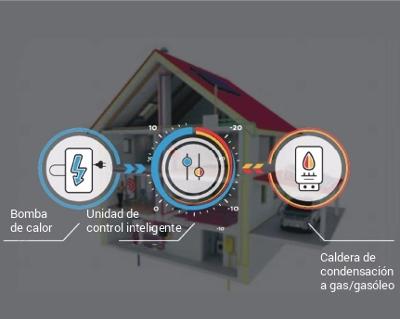

The advantages of hybrid heating and SHW systems
A hybrid heating installation combines different energy sources in a single system. However, according to FEGECA, only a few combinations tend to make sense from the financial point of view and in terms of energy efficiency.
Hybrid installations are characterised by their flexibility and the possibility of expanding the system at any later time, explains FEGECA (Spanish Association of Manufacturers of Generators and Heaters). Those systems which have at least two heat generators are also called bivalent systems and they exploit the advantages of each source: the reliability, security and rapidity of a boiler versus the reduction in costs and emissions of renewable energies. To save on heating costs in the long term and contribute as much as possible to the protection of the environment, it particularly makes sense to include at least one renewable-energy heat source in the system.
Solar thermal energy
Thanks to the climatic conditions of our country, an adequately-sized solar installation in combination with a heat pump permits a very high renewable-energy contribution, which can be close to 100% in the Summer months when solar radiation is very high. That option is currently the most widespread, especially in new builds, but it is not the only possibility.
The most common combination is a diesel oil boiler with a solar thermal energy installation. Those systems were adopted little by little after the oil crisis of the 1970s. Since then, the use of solar thermal energy combined with a boiler has become the standard, and, from the time of entry into effect of the Technical Construction Code (CTE) in 2006, it became an obligatory system in new constructions in Spain. That stipulation and the boom in construction at that time meant unexpected growth of that technology, to around 465,000m² of collectors in 2008.
With the approval of RD 732/2019, important changes were made to the Technical Construction Code, especially in section HE4 on the minimum contribution of renewable energy to cover the demand for sanitary hot water. Solar thermal energy is no longer specifically mentioned, facilitating the use of other renewable energy sources. That has given rise to a wide variety of applications of hybrid systems in the construction of homes. In addition to heat pumps, it is also possible to use biomass or renewable cogeneration.
Photovoltaic
Photovoltaic solar energy is another technology that has recently been adopted in hybrid systems, to support, for example, the heat pump and to increase the contribution of renewables. That also requires greater regulation and control capabilities. It is a good idea to increase the setpoint temperature of HSW or of the buffer tank in order to take advantage of the surplus photovoltaic energy production in the central hours of the day and accumulate it in the form of thermal energy. That raising of the temperature of the tank can be done by means of a heat pump or even by switching on an electrical resistance, but using only surplus solar energy. For that, the regulation must also be capable of receiving instructions from the inverter of the photovoltaic installation. However, a client who has installed an undersized accumulator in order to save money will not be able to benefit as much from those smart functions.
Biomass
Biomass boilers can be another viable element to complete a system. As with heat pumps, the installation must have a large buffer tank. Once the boiler has been switched on, it cannot be turned off and it must transfer all the heat to the heat storage tank. The operating temperatures are usually higher than in condensing boilers and that can be used to heat up SHW or in heating circuits for radiators. The fuel, in the form of logs, pellets or chips, is available throughout Spain and it is usually the cheapest option. However, the maintenance is more demanding, due to the collection of ashes.



